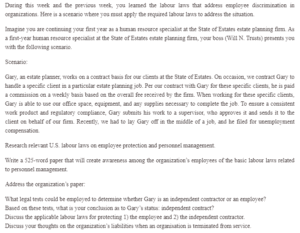Labor Law
Tests employed to determine Gary’s employment status is the Common Law Test. The test includes a guide provided by the IRS and indicates an employee’s eligibility as a worker if the employer can control the work to be done and how to get it done. A worker is classified as an independent worker if the employer can only control or direct the results of the work they do and not what will be done and how to do it. The categories considered in evaluating the evidence of the level of independence and control between a worker and employee are financial aspects, behavioural aspects, and type of relationship (Davies, 2018). The second test is the reasonable basis test based on how the IRS and the courts have classified the same workers in a workplace. In applying the practical test, a worker may be considered an independent worker if there is a court ruling favouring the treatment of a worker in the same situation as an independent worker. An IRS Private Letter Ruling or Technical Advice Memorandum is issued to the company indicating that the worker in question is not an employee and if there is a longstanding broadly recognized practice of treating similar workers and independent contractors in the industry (Davies, 2018). The third test is the hybrid test, which combines the reasonable and standard law tests.
Gary is an independent worker based on the standard law test because he controls his work. The employer only controls and directs the outcome of their work by approving or disapproving their work before sending it to the client. Based on the reasonable test, Gary is an independent worker because he has been outsourced to help the company in estate planning. After all, the current workforce in the company may not have the required knowledge and expertise to do it.
Do you need an original copy of ” Labor Law “ ? Get in touch with us.
The applicable laws for protecting the employee in the current scenario are the Civil Rights Act and the Fair Labor Standards Act. The Civil Rights Act protects employees from discriminatory and unfair hiring and firing practices (Hartman & Bennett-Alexander, 2014). The Fair Labor Standards Act regulates the relationship between an employee and employer regarding compensation and working hours. In the case of Gary, the Act could be applied in determining what Gary should be paid for the work he did before his termination. The applicable law for protecting the independent contractor in the current scenario is the Fair Labor Standards Act. The Act gives independent contractors the right to control, contract, make decisions, work where and when they want, receive payment, advertise, challenge their employment status, work with other contractors and manage their business.
The organization might be accountable for the independent contractor’s wrongdoing if the employer was careless in retaining and selecting the independent contractor. The organization may be responsible if the tasks allotted to the independent contractor should not be delegated and if the work done by the separate contractor exposes the worker to hazards. In assessing an organization’s liability, the court considers whether the organization conducted due diligence before hiring the independent worker to review their experience, background, and competence before making the hiring decision. The court also assesses the nature of the work performed by the independent contractor and the dangers to other people.
References
Davies, B. (2018). Independent contractor or employee? SSRN Electronic Journal. https://doi.org/10.2139/ssrn.3316441
Hartman, L., & Bennett-Alexander, D. (2014). Employment law for business. McGraw-Hill Education.
Levesque, R. J. (2018). Fair Labor Standards Act. Encyclopedia of Adolescence, 1293-1294. https://doi.org/10.1007/978-3-319-33228-4_725
ORDER A PLAGIARISM-FREE PAPER HERE
We’ll write everything from scratch
Question
During this week and the previous week, you learned the labour laws that address employee discrimination in organizations. Here is a scenario where you must apply the required labour laws to address the situation.

Labor Law
Imagine you are continuing your first year as a human resource specialist at the State of Estates estate planning firm. As a first-year human resource specialist at the State of Estates estate planning firm, your boss (Will N. Trusts) presents you with the following scenario.
Scenario:
Gary, an estate planner, works on a contract basis for our clients at the State of Estates. On occasion, we contract Gary to handle a specific client in a particular estate planning job. Per our contract with Gary for these specific clients, he is paid a commission on a weekly basis based on the overall fee received by the firm. When working for these particular clients, Gary is able to use our office space, equipment, and any supplies necessary to complete the job. To ensure a consistent work product and regulatory compliance, Gary submits his work to a supervisor, who approves it and sends it to the client on behalf of our firm. Recently, we had to lay Gary off in the middle of a job, and he filed for unemployment compensation.
Research relevant U.S. labour laws on employee protection and personnel management.
Write a 525-word paper that will create awareness among the organization’s employees of the basic labour laws related to personnel management.
Address the organization’s paper:
What legal tests could be employed to determine whether Gary is an independent contractor or an employee?
Based on these tests, what is your conclusion as to Gary’s status: independent contract?
Discuss the applicable labour laws for protecting 1) the employee and 2) the independent contractor.
Discuss your thoughts on the organization’s liabilities when an organization is terminated from service.

